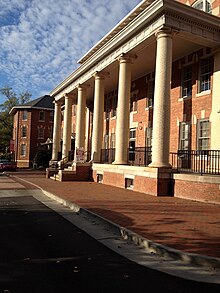Federal Writers' Project – Life Histories/2021/Summer/105/Section 15/John Thomasson
Federal Writers' Project – Life Histories/2021/Summer/105/Section 15/John Thomasson | |
|---|---|
| Born | John Thomason 1889 North Carolina, U.S. |
| Died | Unknown |
| Spouse(s) | Unknown |
| Children | None |
John Thomason
[edit | edit source]Overview
[edit | edit source]John Thomason was a soldier in the United States Army from Piedmont in North Carolina in the 1910s. He was interviewed by Douglas Carter for the Federal Writers' Project on February 23, 1939.[1]
Biography
[edit | edit source]Early Life
[edit | edit source]
John Thomason was born in 1889 in the Piedmont section in North Carolina. As a child, he worked on the family farm. As he got older he went to North Carolina State University and studied in the agricultural and mechanical college. Within two years of starting school, he dropped out because he had found a job that had him learning how to build buildings. The job had him building businesses all across the South and by the end of it, he had worked in almost every state south of Pennsylvania and east of Texas. After completing a job at an army camp, John joined the United States Army where he immediately noticed racial disparities, as black soldiers were forced to work instead of train. He was made into a sergeant major, and his duties at the camp were mainly focused on building, due to his prior experience. Shortly after joining the United States Army, World War 1 broke out, and John was sent to Europe in 1917 where he was stationed in France. He started out serving with the British Army and then was moved to the French Army. After serving for two years, in May 1919 John departed from Brest, France on board a ship back to America on account of him being ordered home. Shortly after arriving in America, John was discharged from the United States Army.[1]

Later Life
[edit | edit source]After being discharged from the United States Army, John got his old job back with the building business. On one job, John saw an interesting opening for a building supply venture and he decided to undertake it due to his long-term desire of becoming an entrepreneur. He opened up warehouse space near the Bald Mountains and began to supply materials to a wide variety of building businesses. Within a couple of years, he converted his business to focus on lumber creation instead of being the supplier, as he found the production end of the business to be more lucrative. After this conversion, John got married in 1925 and bought himself a permanent home in North Carolina.[1]
Social Issues
[edit | edit source]Racial Inequality in the Military
[edit | edit source]Throughout America in the 1900s, segregation was very prevalent in all aspects of life, including the military. Black soldiers were segregated into separate battalions in the military where they "were restricted to a minimal role and rigidly segregated"[2]. On top of being physically separated from the other members of the military, black soldiers were often exclusively handed labor-intensive duties which they were forced to do instead of training. Additionally, black battalions often had to deal with "systemic racial discrimination and slander from their fellow white soldiers and officers"[3] due to the overarching racial inequalities. Their roles were usually much lesser than the white soldiers and they were not always allowed to serve in each branch of the military.[2]
The United States in World War I
[edit | edit source]World War I began in 1914 after Archduke Franz Ferdinand was assassinated in Sarajevo. This assassination began a chain reaction of countries joining the conflict due to long strings of formed alliances, eventually turning into a world war[4]. At first, the United States did not want to enter the war as President Woodrow Wilson desired to remain neutral on the conflict, in line with the opinions of the general American public. However, after several losses in cargo ships, merchant ships, and civilian casualties, there was increasing pressure to join the war. Eventually, on April 6, 1917, Congress voted in favor of joining the war and therefore declared war on Germany[5]. Shortly after the United States declared war, American forces arrived in Europe in June of 1917. The United States sent around 2 million men to serve in World War 1 at the start and most of the American fighting was concentrated in France and England. The war ended in 1918 and there was a total of 40 million casualties altogether[4]. Once the war ended "the nation plunged into recession as 4 million able-bodied men returned home looking for jobs at the very moment that the US and Allied governments canceled thousands of wartime manufacturing contracts"[6] which resulted in tough times for some soldiers.
Works Cited
[edit | edit source]- ↑ 1.0 1.1 1.2 Folder 320: Carter, Douglas (interviewer): A Good Time in the Army, Federal Writers' Project papers #3709, Southern Historical Collection, The Wilson Library, University of North Carolina at Chapel Hill. https://dc.lib.unc.edu/cdm/singleitem/collection/03709/id/670/rec/1
- ↑ 2.0 2.1 Dalfiume, Richard M. "Military Segregation and the 1940 Presidential Election." Phylon (1960-) 30, no. 1 (1969): 42-55. Accessed July 16, 2021. doi:10.2307/273357.
- ↑ Williams, Chad. “What Came After World War I for African-American Veterans.” Time. Time, November 12, 2018. https://time.com/5450336/african-american-veterans-wwi/.
- ↑ 4.0 4.1 Johnston, William M. "SOME CAUSES OF WORLD WAR I AND HISTORIANS' TABOOS." The Journal of General Education 39, no. 2 (1987): 77-84. Accessed July 16, 2021. http://www.jstor.org/stable/27797105.
- ↑ Knispel, Sandra. “Why Did the U.S. Enter World War I?” NewsCenter, October 14, 2020. https://www.rochester.edu/newscenter/looking-back-100-years-u-s-enters-world-war-i-on-april-6-1917/.
- ↑ Keene, Jennifer. “A ‘Brutalizing’ War? The USA after the First World War.” Journal of Contemporary History 50, no. 1 (January 2015): 78–99. https://doi.org/10.1177/0022009414546506.